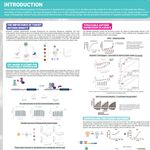Senior Director, Spatial Genomics Business Unit, NanoString Technologies
BIOGRAPHY

MAY 31, 2022 9:00 AM PDT
Interrogate tumor-immune interactions in AML patients receiving immune checkpoint inhibitor
Sponsored by: NanoString Technologies
Speakers
-
Dr. Chen Zhao
MD, Assistant Clinical Investigator, Medical Oncologist, Immunologist, Physician-Scientist, Center for Cancer Research, National Cancer InstituteBIOGRAPHY
Event Date & Time
Date: May 31, 2022
Time: 9:00am (PDT), 12:00pm (EDT), 6:00pm (CEST)
Abstract
Introducing Nanostring’s latest spatial platform, CosMx Spatial Molecular Imager (SMI). Offering high-plex, multiomic in situ analysis with single-cell to subcellular resolution in intact Formalin-Fixed Paraffin-Embedded (FFPE) and fresh frozen tissue sample. Learn how CosMx SMI advances spatially resolved single cell applications including cell atlasing, cellular neighborhoods analysis, biomarker discovery and subcellular localization analysis.
In today’s talk Dr. Chen Zhao will elaborate on how his lab spatially resolved the tumor-immune interactions in the bone marrow microenvironment to gain a deeper understanding of the tumor-immune microenvironment in R-AML during combination ICI treatment.
Relapsed or refractory Acute Myeloid Leukemia (R-AML) is a deadly disease with an inadequate response rate to current treatments. Recent advances in immunotherapy shed light on R-AML, and several clinical trials have shown promising potential for combining immune checkpoint inhibitors (ICIs) with hypomethylating agents. Comprehending the tumor-immune microenvironment in R-AML during combination ICI treatment is urgently needed for developing better therapeutics and stratifying treatment strategies.
To dissect the tumor-immune interactions in the bone marrow microenvironment, Dr. Zhao’s team employed NanoString GeoMx Digital Spatial Profiler (DSP), CosMx SMI, and performed a spatial-transcriptomic analysis of patients with R-AML who received pembrolizumab and decitabine. Comparing the transcriptomic profiles and TCR clonalities of tumor-interacting T cells, bystander T cells, and other cells at baseline, post-pembrolizumab treatment, and post-decitabine, led to identification of R-AML’s suppressive immune microenvironment and immune cells’ responses to ICI and hypomethylating agent.
The spatial-transcriptomic profiles of T cells, stromal cells, and leukemia cells in patients with R-AML were obtained at different treatment points. The TCR-specific probes were able to track T cell clonal changes during treatments. R-AML harbored a complex tumor immune microenvironment and diverse T cell clonality.
Learning Objectives
- Understand how Nanostring’s GeoMx DSP and CosMx SMI spatial platforms were used to determine the spatial transcriptomic profiles T cells, stromal cells and leukeumia cells in patients with R-AML
- Learn how CosMx SMI is able to spatially resolve T-cell clonal changes during treatment
- Learn how diverse T-cell clonality impacts the tumor-immune microenvironment in R-AML during combination ICI treatment
Webinars will be available for unlimited on-demand viewing after live event.
You May Also Like
OCT 02, 2024 | 7:30 AM
De novo gene synthesis and protein expression are established technologies that can give access to nearly any target DNA or protein sequence, allowing for engineering of biologics. In this p...
Speaker:
Claudia Chiocchini
Presented at: Cancer Research & Oncology Virtual Event Series 2024
Sponsored By: Thermo Fisher Scientific
Sponsored By: Thermo Fisher Scientific
DEC 10, 2024 | 9:00 AM
To-date, proteomic analysis has been severely limited in scale and resolution. Analyzing protein samples using an intact, single-molecule approach holds th...
APR 21, 2025 | 1:00 PM
C.E. CREDITS
Routine coagulation assays are widely performed in laboratories and provide valuable information to the patient’s overall clinical picture. It’s important for laboratorians to kn...
Speaker:
Malissa S Norfolk, MBA, PMP, MLS(ASCP)ᶜᵐSHᶜᵐ
FEB 25, 2025 | 1:00 PM
C.E. CREDITS
Quality efforts in the clinical laboratory are always under the microscope- a hyper-focus for laboratorians from start to finish. Recognizing the external factors that affect hemostasis test...
Speaker:
Rae Kerlin, BS, MLS (ASCP), NCA
MAR 19, 2025 | 11:30 AM
Join this year's poster presenters in the Poster Hall during the Poster Networking Hour, Wednesday, March 5th, from 10:00 –11:00 AM PDT , to chat...
Loading Comments...
Please update your information
Certificate of Attendance
Thank you for choosing Labroots. Please note that a Certificate of Attendance does NOT count towards Continuing Education Credits.
DOWNLOAD CERTIFICATE
DOWNLOAD CERTIFICATE
You must watch the entire webinar to receive your certificate of attendance.
You must attend the event before receiving your certificate of attendance.
You must register for the event first.
Certificate is no longer available for this event.
You must be logged in to retrieve your certificate.






